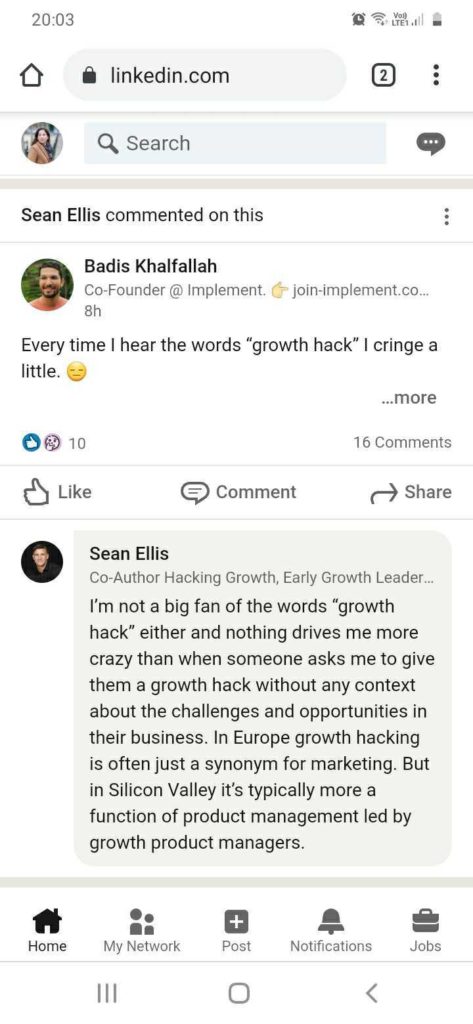Growth Hacking is not new. The term has been around since 2010. However, prejudices and misunderstandings are still prevalent. Job offers for Growth profiles (Growth Engineer, Growth Marketer, Growth Hacker) can be counted by the hundreds. But, many published missions miss what this job is really about. And, the training that promise you to become a lead generation bully, will only teach you part of the job.
Last month, I was invited by 42 Entrepreneurs to give a talk on Growth. The topic was free, so I chose to title my talk “Growth, the good, the bad, the ugly”. I took advantage of this talk to share what I like about my job. But, I was also honest about the difficulties and obstacles one encounters in this business, especially when one feels misunderstood.
And, then recently, while browsing my LinkedIn, I came across this comment from Sean Ellis, who popularized the concept of growth hacking.

He reminds us of two important things: Growth Hacking is not only about hacks (it’s not even that). And, that in Europe, we are still late to adopt a method around the product. A lot of Growth in Europe are only doing digital marketing.
It is this comment that made me want to write this article in order to, I hope, allow our business to move in the right direction.
Idea #1: without Product-Market Fit, no Growth Hacking
If you still haven’t validated your Product-Market Fit, don’t hire a Growth Hacker to accelerate your acquisition. Too many entrepreneurs think too quickly about distribution and want to hire an expert for maximum conversions. But, if your product isn’t a good fit or is aimed at the wrong market, all the acquisition techniques in the world won’t make up for that. And, when this type of case occurs, some entrepreneurs will prefer to blame their Growth Hacker rather than question the product.
Recently, two entrepreneurs contacted me asking for advice on hiring a Growth Hacker. My first question was, has your product found its PMF? They replied that it did. The conversation continued and as we talked, I found out that they only have a small handful of listings for their product. Yet, they have a massive community on their Facebook group dedicated to the same topic as their product. They promote their product daily to their community, but only a few members have jumped on board. This seemed like very little traction to me to validate a PMF. I finally advised them to keep working on their product rather than hiring. I hope they heard my advice.
Nevertheless, some Growth profiles are quite comfortable with the idea of working for a company that is still looking for its PMF. They like the challenge of testing several value propositions on different targets. These profiles are willing to take the risk of joining a start-up that may never find its PMF and never take off. But, these profiles are rare, and they are often looking for an associate role. The important thing when recruiting pre-PMF is to be very transparent so that the profiles that join you know the risks.
Idea #2: It’s not just one person’s job
Hiring a Growth Hacker alone in his corner to apply Growth methods will not create miracles. He will certainly be able to achieve some results, but he will be blocked if he wants to experiment outside his field of action. If the other teams already have their methods, routines, and schedules and a Growth Hacker comes in from nowhere to shake things up, he or she may not be well received.
By hiring a single person to apply Growth methods, here is the type of situation that can happen:
The Growth Hacker has an idea for a test to run on the website, he goes to the developers to ask them to code this idea, the developers will answer “sorry, we don’t have time”. Failure. The Growth Hacker does not give up. He set up another experiment the week before and would like to get some data. He goes to the data team and their answer might be “sorry, we don’t have the time to track the data you are asking for in our data lake”. Well, another failure. But the Growth Hacker doesn’t despair and wants to do an A/B test on the homepage content. But the answer from the marketing department is “no, it doesn’t fit the branding we decided between us”. After all these failures, the Growth Hacker gives up and will limit himself to his tasks until he is tired of them.
Growth Hacking as explained in Sean Ellis’ book is not reserved for a profile, it does not describe a profession. He explains Growth Hacking as a method that can be applied to a multidisciplinary team. The composition of the team will depend on the business model and the size of the company, as well as the nature of the North Star metric. But, a good Growth team composition will generally be composed of at least a Data Analyst, a Marketer, a Product Manager and a Developer. Occasionally, this team evolves, and the members change according to the projects tackled, these are sometimes temporary squads. And, when the company is ready to recruit a permanent Growth department. They will then recruit a Head of Growth, a Growth Engineer, a Growth Analyst, a Growth Marketer… Only the job titles change, not the skills.
Of course, when you start your company, you may not have the budget to hire a whole Growth team. But that’s okay. The important thing is that your employees are trained in a methodology of experimentation and that if you hire a Growth Hacker not to set him up for failure.
Idea #3: It’s not all about acquisition and lead generation
Every day, I see job postings for Head of Growth/Growth Manager/Growth Marketer and for 80% of these jobs, the description contains only acquisition tasks. Yet, they are not titled “Acquisition Manager”. Where are the other letters of the AARRR? However, even a Growth Hacking aware entrepreneur knows the content of this acronym. So, why, I see so few Growth assignments that include retention or monetization?
The same goes for Growth Hacking training courses that promise you to become “lead generation bullies”. Where’s the activation, retention, referral, and revenue?
For these job postings, why do they use the term “Growth” if they need an Acquisition Manager instead? Is it to have a sexier job title?
Let’s take the case of a Growth profile hired for a job that only contains acquisition missions. At the beginning, everything goes well, he uses various techniques to make money. The results follow, he gets a pat on the back. But, after a while, the Growth Manager starts to go in circles and would like to know what happens after the lead is converted. He wants to expand his responsibilities or create a team to dedicate himself to each stage of AARRR. In case everything goes well, his manager approves, he moves him to the other stages. Growth is happy to include diversity in his daily routine and apply testing to the rest of the customer journey.
But just in case, it doesn’t go well. The Growth goes to the manager, points out that there is a hole in the retention racket, and has some ideas. The manager says, “Don’t worry about that, we have a support team that handles churn. Just worry about bringing in more leads, we have a second round of funding to negotiate. Investors want to see numbers.” Following this, the Growth person goes back to their acquisition job and over time, their day-to-day life looks more like a Traffic Manager profile than a Growth Manager profile.
Again, I’m going to rely on Sean Ellis’ book. Again, him. But, his examples in the book have nothing to do with lead generation. He basically describes experiments and improvements that take place on the product, user data or copywriting. Actions that also increase the number of users without scrapping. I don’t question the importance of lead generation. But to limit the missions of a Growth profile to that is to miss other opportunities.
Idea #4: It’s not chance or luck but an organized cycle of experimentation
Hacks are cool, they sell well in a LinkedIn post or a video. However, hacks are very frequently intrinsic to the product from which they emerge. There is no point in copying the ones you find on the Internet. In very few cases, they will be useful for your growth. What works here may fail elsewhere. You must adapt your methods and tests to your product. It is important to be inspired by what is happening elsewhere, but it is not enough if you do not have your system of experimentation.
Not all hacks are born from the genius mind of a Growth Hacker. A Growth Hacker who succeeded in growing a B2B software may fail if he transitions to a B2C e-commerce. In particular, if he replicates the same methods without considering the new types of users he will address. Moreover, many hacks succeed only by chance. It is by accumulating experiments and rejecting almost no idea that one can achieve success. As long as you stick to ideas that don’t go against the user experience, you should test everything. There is no secret, no magic formula. You have to test, test and test… Some experiments will be successful, others will be failures, and many will only bring a slight improvement. Not enough to make a viral publication on social networks, but these slight improvements will have enough impact if you accumulate them over time.
I hope this article will help debunk some myths around Growth and its business.
Share your thoughts on Growth in the comments.
Thank you for reading.

Leave a Reply